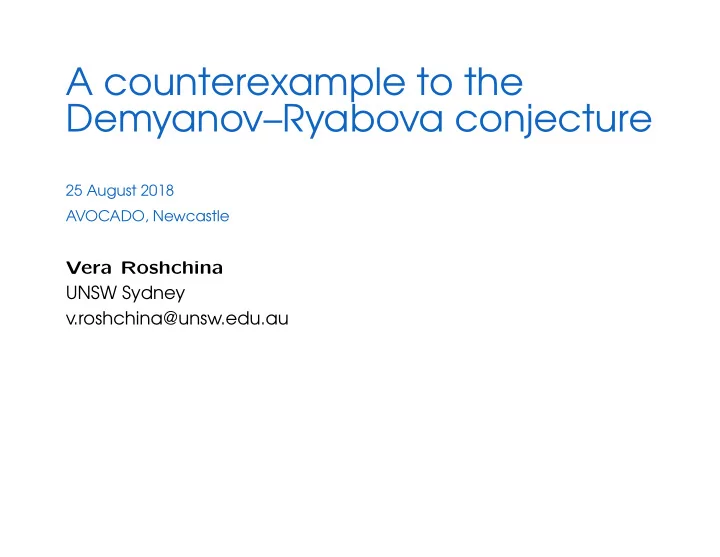

A counterexample to the Demyanov–Ryabova conjecture 25 August 2018 AVOCADO, Newcastle Vera Roshchina UNSW Sydney v.roshchina@unsw.edu.au
Demyanov Converter � � For a finite set of polytopes Ω , C (Ω) = conv P ∈ Ω Arg max � x, g � , g � = 0 . x ∈ P Arg max � x, g � P 1 x ∈ P 1 g Arg max � x, g � x ∈ P 1 P 2 Application: conversion between upper and lower envelopes, P ∈ Ω max min u ∈ P � x, u � = P ∈ C (Ω) min max v ∈ Q � x, v � .
The Demyanov–Ryabova conjecture The sequence Ω 0 , Ω 1 , Ω 2 , . . . , where Ω i +1 = C (Ω i ) , eventually cycles, so Ω N + L = Ω N for some N, L ≥ 0 . Conjecture: The length of the minimal cycle is at most 2. True when • all vertices are affinely independent (T. Sang); • all vertices are extreme points of conv Ω 0 and Ω 0 contains all poly- topes of minimal cardinality (A. Daniilidis and C. Petitjean). Demyanov, Vladimir F .; Ryabova, Julia A. Exhausters, coexhausters and converters in nonsmooth analysis. Discrete Contin. Dyn. Syst. (2011). Sang, Tian On the conjecture by Demyanov-Ryabova in converting finite exhausters. J. Optim. Theory Appl. (2017). Daniilidis, Aris; Petitjean, Colin A partial answer to the Demyanov-Ryabova con- jecture. Set-Valued Var. Anal. (2018).
Counterexample y P 3 P 2 P 1 P 4 x For Ω 0 = { P 1 , P 2 , P 3 , P 4 } we have Ω 1 = Ω 5 , but Ω 1 � = Ω 3 . Roshchina, V ., The Demyanov–Ryabova conjecture is false, Optim. Lett. (2018).
Ω 1 = Ω 5 3 3 3 3 2 2 2 2 1 1 1 1 0 0 0 0 1 1 1 1 2 0 2 2 0 2 2 0 2 2 0 2 3 3 3 3 2 2 2 2 1 1 1 1 0 0 0 0 1 1 1 1 2 0 2 2 0 2 2 0 2 2 0 2 3 3 3 3 2 2 2 2 1 1 1 1 0 0 0 0 1 1 1 1 2 0 2 2 0 2 2 0 2 2 0 2
Ω 3 3 3 3 3 2 2 2 2 1 1 1 1 0 0 0 0 1 1 1 1 2 0 2 2 0 2 2 0 2 2 0 2 3 3 3 3 2 2 2 2 1 1 1 1 0 0 0 0 1 1 1 1 2 0 2 2 0 2 2 0 2 2 0 2 3 3 3 3 2 2 2 2 1 1 1 1 0 0 0 0 1 1 1 1 2 0 2 2 0 2 2 0 2 2 0 2
Recommend
More recommend